Hubble Space Telescope Reveals Fantastic View of The Veil Nebula
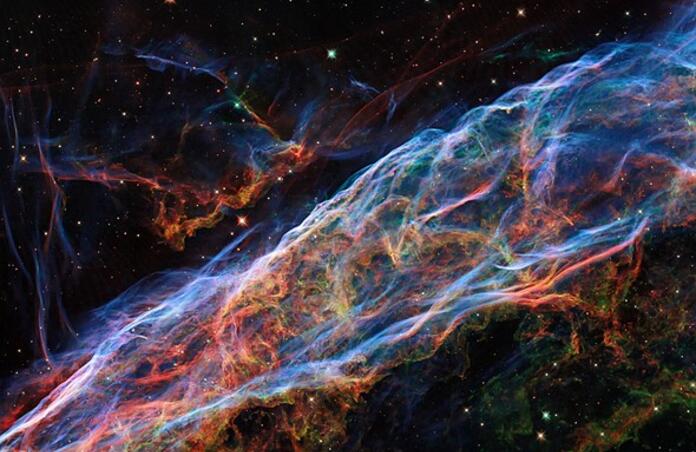
Data from the Hubble Space Telescope (HST) has been reprocessed to reveal additional features of the Veil Nebula.
The Veil Nebula is a supernova remnant. 10 000 years ago, a star with 20 times the mass of the Sun ended its life in a great explosion, ejecting most of its matter and producing a shockwave. The remnant is only 2 000 light-years away from Earth, in the constellation Cygnus - it is often referred to as “Cygnus Loop” - and has a diameter of 130 light-years, so that it covers an area of sky six times larger than the full Moon! Since its magnitude is 8, slightly lower than what is required to be observable with the naked eye, the Veil Nebula was first discovered by William Herschel in 1784. Subsequently, the entire nebula was observed; it is so large that different parts of it have received individual catalogue names. The portion that the HST has observed in the Western Veil is shown below too – it still required 6 images to cover that whole area, about 2 light-years across.
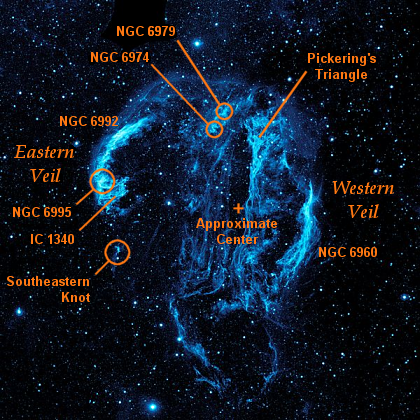
Labeled NASA photograph of the whole Veil Nebula
in ultraviolet light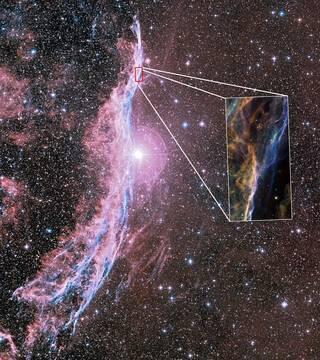
Caldwell 34 (Western Veil) by a ground-based telescope and the HST's close-up
The Wild Field and Planetary Camera 2 (WFPC 2) used to obtain the 1994 and 1997 images is equipped with 48 filters on 12 filter wheels, the 3 that were used are oxygen (blue), sulphur (green) and hydrogen (red). This is the typical colouration used due to the wavelengths at which these elements, when ionized, emit. The 2015 images were taken with WFPC 3, which was installed in place of WFPC 2 in 2009. It has higher resolution, a larger field of view and can also conduct observations over a wider range of wavelengths, spanning from near-infrared to near-ultraviolet. The filters that were used to image the Veil Nebula though are similar to the 1997 ones: oxygen (blue), sulphur (green), hydrogen (red) as well as nitrogen (combined in the red) and exposures in Blue and Near-Infrared.
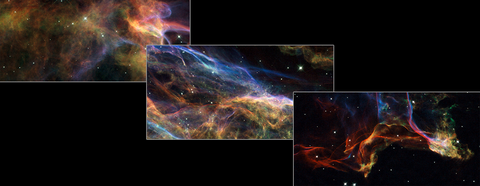
1994 / 1997 HST images 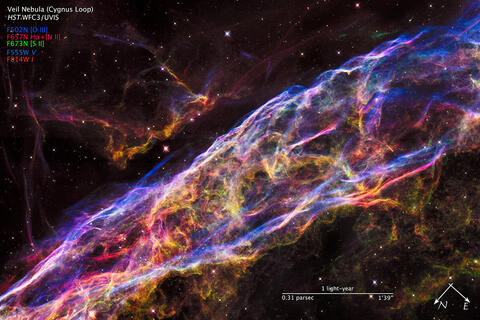
The 2015 image
Comparing the 1997 images to the 2015 HST images, astrophysicists were able to establish the expansion rate: 1.5 million kilometres per hour. Moreover, NASA’s new processing technique enhanced detailed from the ionized gases’ emission (cover image). It is thought that the star, prior to the supernova explosion, expelled matter as stellar wind. Then, as the shock from the supernova progresses into the cool interstellar medium, it also hits that gas, notably forming the observed brighter regions where that gas is densest.
The filamentary structure can be explained by shock waves which are thin, about one part in 50 000 of the radius of the nebula. Oxygen has encountered the shock wave more recently, while the red features have had more time to diffuse. In particular, the thin red Hydrogen filaments give information about the propagation, as the Hydrogen gas gets excited directly at the shock front.
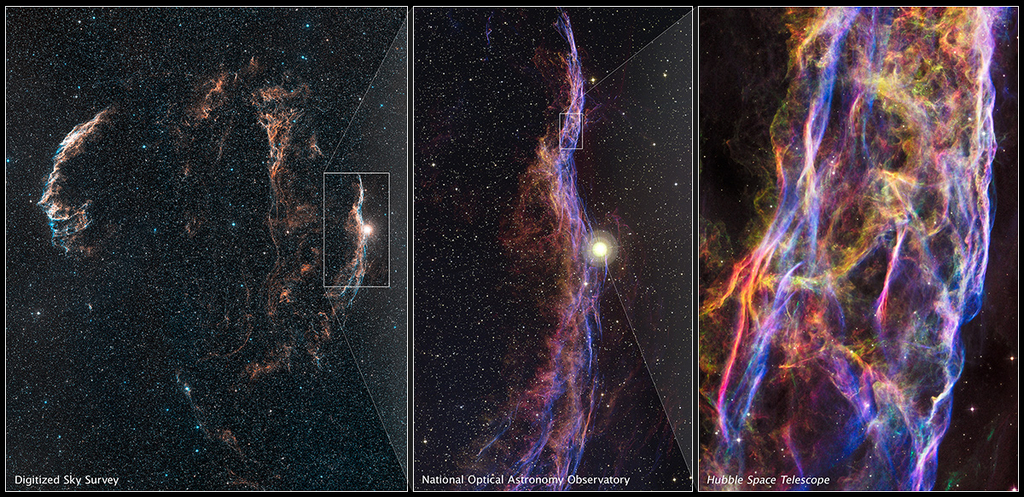
Now is the time to observe Cygnus Loop from the Southern Hemisphere. Target the Eastern Veil (NGC 6992) or the Western Veil (NGC 6960), or try to get a wide-field image of the whole nebula with CHI-5 ! H-alpha, O III and S II filters similar to the ones used with the HST are available for you to produce the same colour-composites.
Cover Image: 2021 reprocessed image, ESA/Hubble & NASA, Z. Levay
Image Credits:
1 - Labeled Cygnus Loop in ultraviolet light, NASA/JPL-Caltech, annotated by Elphion for Wikimedia Commons
2 - NASA, ESA, and the Hubble Heritage (STScI/AURA)-ESA/Hubble Collaboration, and the Digitized Sky Survey 2
3 - NASA, ESA, and the Hubble Heritage (STScI/AURA)-ESA/Hubble Collaboration
4 - NASA, ESA, and the Hubble Heritage Team (STScI/AURA)
5 - NASA, ESA, the Hubble Heritage Team (STScI/AURA), Digitized Sky Survey ((DSS) STScI/AURA, Palomar/Caltech, and UKSTU/AAO), and T.A. Rector (University of Alaska, Anchorage) and WIYN/NOAO/AURA/NSF
